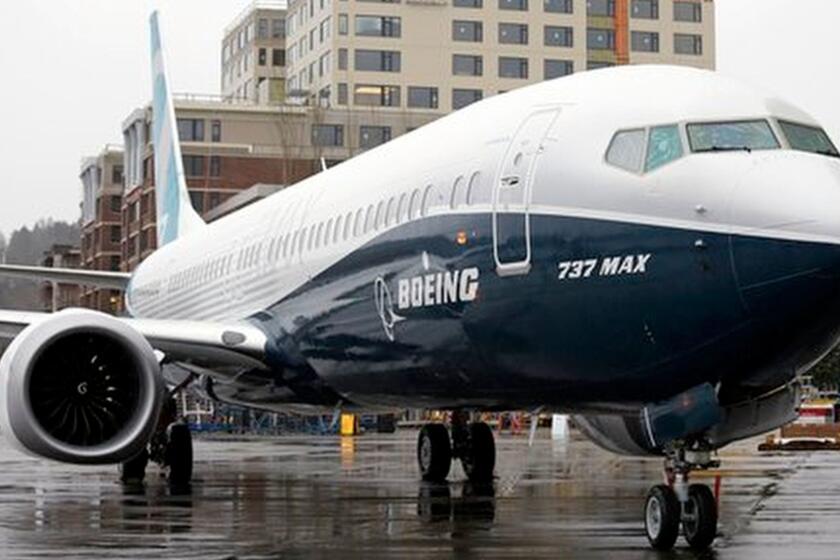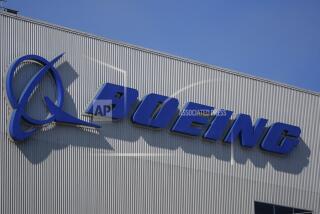Column: Boeing’s landmark union contract seeks to reverse its horrible executive decisions since the turn of this century

- Share via
Reporting on the announcement Sunday that Boeing Co. had reached a landmark contract agreement with its largest union tended to focus on its economic components, such as wage increases of 25% to 33% over four years, a reduction in employee costs for healthcare and improvements in retirement benefits.
Rather less attention was paid to the implication of another provision of the deal with the International Assn. of Machinists and Aerospace Workers, which represents 33,000 Boeing workers: the company’s commitment to build its next new aircraft in Washington state instead of its nonunion outpost in South Carolina.
Boeing management portrayed that provision as a sort of community-building effort.
When people say I changed the culture of Boeing, that was the intent, so that it’s run like a business rather than a great engineering firm.
— Former Boeing CEO Harry Stonecipher misses the point
“This contract deepens our commitment to the Pacific Northwest,” Stephanie Pope, chief executive of the company’s commercial airplanes division, said in a video message to workers. “It is where generations of workers have built incredible airplanes that connect the world.”
That means “job security for generations to come,” she said. “It’s a big commitment to you and to our community.”
Get the latest from Michael Hiltzik
Commentary on economics and more from a Pulitzer Prize winner.
You may occasionally receive promotional content from the Los Angeles Times.
Yet there may be more to that commitment: It’s a tacit acknowledgment that Boeing’s decades-long effort to juice its share price and maximize its short-term profits by undervaluing its traditions of superb engineering and rigorous quality control has failed by turning it into a corporation that makes neither money nor trustworthy products.
Boeing hasn’t turned a profit since 2018. Its aircraft have a troubling reputation for falling out of the sky and coming apart in mid-flight.
Its Starliner, which is designed to ferry crews to and from the International Space Station, has been judged so unreliable that NASA determined that it was safer to strand two astronauts on the ISS until February than to bring them back to Earth on the Boeing craft. (The Starliner returned to Earth Saturday, minus the astronauts.)
California reached an agreement with Boeing over cleaning up Santa Susana after secret negotiations. Why?
Put it all together, and the Boeing story looks like an object lesson in what happens when management takes its eye off the ball — or more precisely, puts it eye on the wrong ball.
The focus by a series of managements on profits and shareholder returns rather than the Job One of building good products is a classic case of mistaking the scoreboard for the game. When that happens, more often than not you lose the game.
Boeing’s string of disasters dates back to just before the turn of this century. Let’s examine the record.
The first misstep was Boeing’s acquisition of the failing McDonnell Douglas in 1997. “In contrast to Boeing’s culture of engineering excellence, McDonnell Douglas focused on cost-cutting and upgrading older airplane models at the expense of all-new aircraft,” Bill George, an executive fellow at Harvard Business School, observed earlier this year.
Bizarrely, it was the culture of the acquired company that prevailed at the acquirer. McDonnell Douglas executives supplanted Boeing veterans at the highest echelons of Boeing management — exemplified by the appointment of Harry Stonecipher, who was CEO of McDonnell Douglas at the time of the merger, as CEO of Boeing in 2003.
Stonecipher’s predecessor at Boeing, Philip Condit, had resigned in the aftermath of a scandal involving the attempted recruitment of a Pentagon official while she was overseeing Boeing government contracts. (Stonecipher was forced out in 2005 because of an intimate relationship with another Boeing executive.)
In the Boeing corridors, the standing joke was that “McDonnell Douglas bought Boeing with Boeing’s money.”
Condit had taken a second step toward crippling the company’s engineering culture in 2001, when he orchestrated a move of corporate headquarters from Seattle, where it had been based since its founding in 1916, to Chicago.
Boeing will be hobbled by the 737 Max affair for years to come. Yet the board that oversaw this calamity is not being held to task.
Condit’s team rationalized the move by talking about the need to be in an international transportation hub offering “cultural diversity” and a reasonable cost of living, but Seattle met all those requirements.
What Chicago offered, however, were tax abatements and other benefits worth $60 million. Management depicted the fact that the move put nearly 2,100 miles between headquarters and Boeing’s most important business segment, commercial aircraft, as a virtue: After all, it immunized the C-suite from being swayed by the concerns of its engineering and quality staff, as if that was a good thing.
“When the headquarters is located in proximity to a principal business,” Condit said, “the corporate center is inevitably drawn into day-to-day business operation.”
Stonecipher was the incarnation of a profits-at-all-cost mentality. “When people say I changed the culture of Boeing, that was the intent, so that it’s run like a business rather than a great engineering firm,” he said in an interview with the Chicago Tribune. “It is a great engineering firm, but people invest in a company because they want to make money.”
Cost-cutting became the theme of Boeing’s operational decisions. In 2019 it announced that it would move all manufacturing of its wide-body 787 Dreamliner to its plant in North Charleston, S.C., ending split responsibilities between that plant and Washington state. The company attributed the change to the need for efficiency, but given South Carolina’s position as a nonunion state, it was widely viewed as a slap at the machinists union, which had staged a 58-day strike in 2008.
A few years ago, Washington state awarded the Boeing Co. the largest corporate tax break any state had given any corporation — a massive $8.7-billion handout aimed at encouraging the aerospace industry generally, and Boeing specifically, “to maintain and grow its workforce within the state.”
Problems promptly emerged at the South Carolina plant, which bristled with whistleblowers. Shards of metal debris were found in electrical housings, where they could have caused short-circuits. Installed parts didn’t work.
Another cost-cutting move — outsourcing design and manufacturing of Dreamliner components to subcontractors around the world — resulted in a comedy of errors causing so many problems that executives acknowledged it would have been cheaper to keep the work in-house. Some parts manufactured by far-flung suppliers didn’t fit together. Some subcontractors couldn’t meet their output quotas, creating huge production logjams when crucial parts weren’t available in the necessary sequence.
Rather than follow its old model of providing parts subcontractors with detailed blueprints, Boeing required suppliers to create their own blueprints. At least one major supplier didn’t even have an engineering department when it won its contract, according to an analysis of the 787 by the European consortium Airbus, Boeing’s top global competitor.
Problems also plagued Boeing’s now-infamous 737 Max airplane, which aimed to be a more fuel-efficient version of its best-selling 737. Two crashes of the new aircraft less than five months apart in 2018 and 2019 — the first flown by the Indonesia airline Lion Air and the second by Ethiopian Air — took the lives of 346 passengers and crew members and resulted in a nearly two-year-long grounding of the planes and nearly a half-billion dollars in fines; the company agreed to plead guilty to a felony charge of defrauding the U.S. government.
In January of this year, a dummy door panel in the fuselage of an Alaskan Airline 737 Max blew out in flight, resulting in a grounding of eight months.
Throughout this whole period, Boeing upstreamed billions of dollars to shareholders in dividends and stock buybacks. That included nearly $31 billion in dividends, including $5.8 billion paid out in 2019 and 2020, years in which the company reported losses totaling more than $12 billion.
787 Dreamliner teaches Boeing costly lesson on outsourcing
From 2013 through 2019, the company repurchased $43.5 billion in shares, a strategy aimed at pumping up its share price. Boeing ended its dividend payout in 2020 and its share buybacks in 2019.
By then the company was confronting a tide of red ink. From 2019 through 2023, Boeing lost $26 billion on revenues of $307.7 billion. Its effort to remake itself — or perhaps return to its roots — hasn’t ended.
It has moved in the wrong direction, if anything. In 2022, it announced it was abandoning its Chicago headquarters and moving to Arlington, Va., ostensibly as a reflection of its role as a government contractor. (The company said the relocation would bring it close to its “customers and stakeholders, and its access to world-class engineering and technical talent” — not that working from Arlington would make it more convenient to lobby on Capitol Hill.)
There may be a sea change at work at Boeing. Its new CEO, Kelly Ortberg — an import from the aerospace firm Rockwell Collins — has expressed the desire to improve its labor relations.
Asked to comment on its dismal long-term performance, the company referred me to a statement Ortberg made last month after meeting with the presidents of the IAM locals representing Boeing workers, in which he said he shared his “commitment to reset our relationship and reach a new contract where we can come together to build a strong future for our employees in the region.”
“Over the coming weeks, I plan to continue visiting our Boeing sites to see the work and meet our teammates. I am impressed by the talent of our people and I am grateful for their candor throughout conversations we’ve had,” he said before the contract settlement. The new contract may help him address its persistent quality problems, and certainly forestalls a machinists’ strike that was threatened to start Thursday, the deadline for union members to ratify the contract.
But the company has a steep hill to climb to win back its reputation as one of America’s outstanding manufacturers. For more than two decades, management teams preoccupied with the bottom line but seemingly unaware that the bottom line depends on turning out a product that customers value squandered that reputation.
Boeing’s story is a Gothic tragedy, and more often than not, those end badly for everyone.
More to Read
Get the latest from Michael Hiltzik
Commentary on economics and more from a Pulitzer Prize winner.
You may occasionally receive promotional content from the Los Angeles Times.













